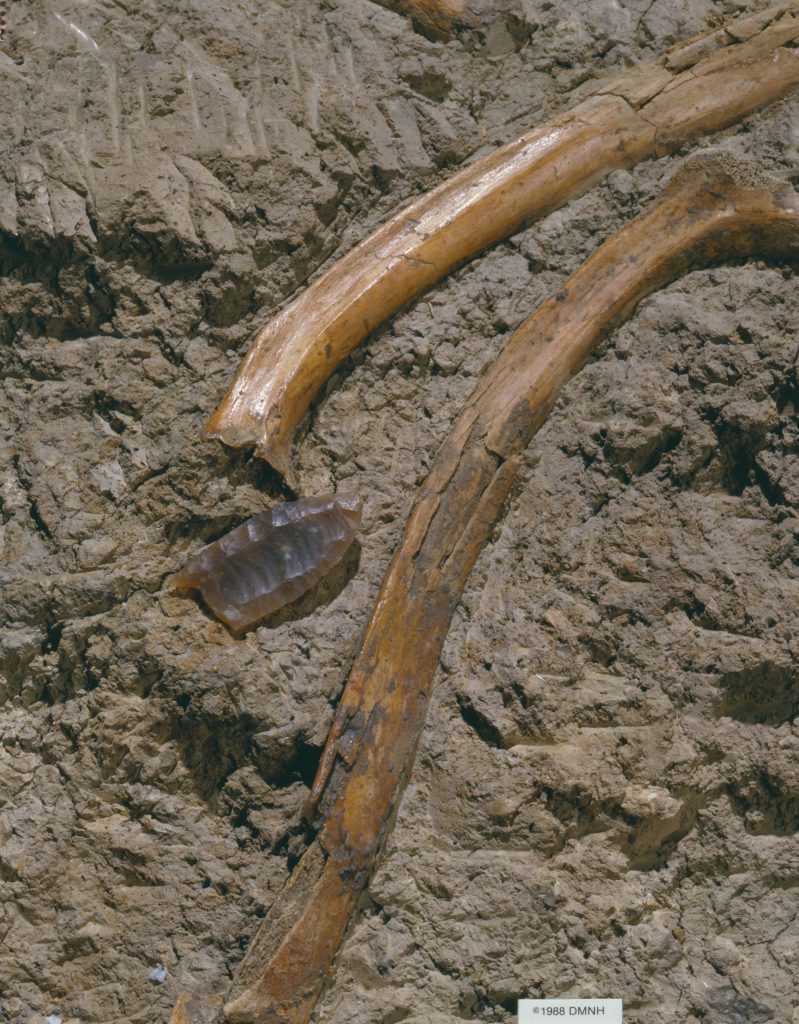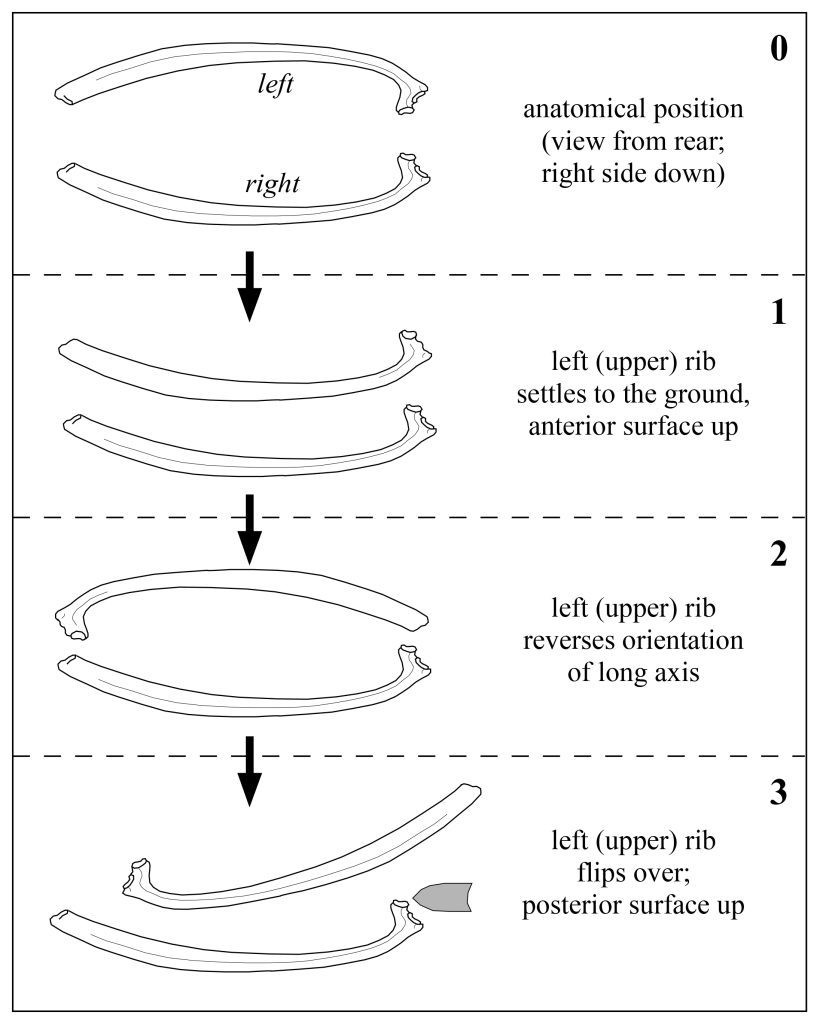Why the Famous Folsom Point Isn’t a Smoking Gun
Remember the iconic Folsom point? The one that I said, in my last post, changed the future of archaeology?
To recap: On August 29, 1927, paleontologists from the Colorado Museum of Natural History (renamed the Denver Museum of Nature & Science in 2000) discovered a stone projectile point embedded in the ribs of an extinct form of bison.
After making that discovery in the field, the researchers left the point sitting where it was and immediately sent out a call to their colleagues to come to northeastern New Mexico to see it for themselves. Within two weeks a number of well-known scientists had visited the site, seen the point in position, and established a scientific consensus: Native Americans lived and hunted in North America during the end of the last Ice Age, about 12,000 years ago, far earlier than they were previously thought to be here.
It turns out, though, that the story at the Folsom Site was more complicated than researchers initially believed. So what has changed since 1927? The latest part of the story began 20 years ago.
In 1997, David Meltzer, an archaeologist at Southern Methodist University who studies “Paleoindians,” the earliest inhabitants of North America, began a three-year project at the Folsom Site to reassess and re-excavate the site using modern tools and techniques—which were not available in the 1920s. His goal was to better understand how, and under what conditions, the Folsom Site formed. Meltzer and his team used now-standard excavation-control techniques to record their findings in three-dimensional space and to determine if any unexcavated areas of the site could be found. In so doing, they hoped to find evidence of the Paleoindian campsite that might have been associated with the main bison-kill and butchering site.
As a result of Meltzer’s research, we now know that the bison-kill event occurred in the fall. How do we know? Bison reproduce, give birth, and grow up on a reasonably predictable annual cycle. Meltzer and his colleagues analyzed dental eruption patterns on excavated bison teeth to determine the season of the kill.
The archaeologists also determined that Folsom hunters were experts at their job, having systematically killed and butchered at least 32 bison at the site.
Meltzer and his team never did find an ancient campsite, however. It may be further up or down Wild Horse Arroyo buried deep in the sediments. It may have already been destroyed. Or it simply may never have been there at all, which would suggest that the group responsible for creating the Folsom Site may have been a hunting and processing party and not the full extended family or social group.
Based on stone-sourcing studies, Meltzer and his team determined that the Folsom Site was but one stop on a wide-ranging itinerary of a nomadic people. The raw materials used to make the iconic Folsom points come from sources located hundreds of miles away from the site, including the Texas Panhandle and northeastern Colorado. Folsom people were highly mobile.
After years of painstaking analysis of museum collections and archives, Meltzer and his team found that up to two dozen Folsom points have been recovered from the site over the years; yet due to poor excavation techniques and site control, the specific find location is known for only three.
As with any project, professionals talk about their work.
At some point, Meltzer mentioned his work at Folsom to fellow archaeologist R. Lee Lyman of the University of Missouri. Lyman is a zooarchaeologist, which means he studies the animal bones that we often find in large quantities at archaeological sites.
Lyman had been aware of the original Folsom discovery since graduate school decades before. Unlike other archaeologists, Lyman has a keen eye for animal bones, and he had long been troubled by what he saw from Folsom. Something about the image of the Folsom point embedded between the ribs of an ancient bison troubled him.
When he finally took time to have a detailed look at the photograph, it hit him like a ton of bricks: Not only are the two ribs from different sides of the animal, they are positioned in the opposite direction of one another! As a result, while we can reasonably say that the Folsom point was found “embedded between” the ribs of a skeletal Ice Age bison, we can’t reasonably say that it was ever “embedded in” the rib cage of the living animal.
It’s a subtle but important distinction. Lyman’s research doesn’t challenge the original interpretation of the Folsom find—he is quick to point out that the Ice Age bones and the Folsom point are still in direct association. His insight, however, means that the iconic Folsom point is less of a smoking gun than previously thought. It appears that our initial fixation on hunting blinded us to the subtleties of this famous archaeological discovery for decades.
What about the age of Folsom points? Do we know how old they are?
When the Folsom Site was originally discovered, its age could not be accurately determined. Until 1949, archaeologists had no reliable dating techniques for Ice Age sites. For all they knew, Folsom could be 10,000, 20,000, or 30,000 years old.
Radiocarbon dating takes advantage of the fact that all living things have radioactive carbon in their tissues and bones. When a plant or animal dies, the radioactive carbon decays at a known rate, called its half-life. (After 5,730 years, half its original radioactive carbon will be left. After another 5,730 years, one-quarter will be left, and so on.) If scientists can accurately measure the amount of radioactive carbon left in an artifact (a bone or a piece of charcoal, for example), there is a relatively simple calculation to determine how long ago the organism died.
In 2016, University of Wyoming archaeologist Todd Surovell and his colleagues analyzed a number of radiocarbon dates to determine that Folsom points, which have now been found over much of North America, were made for some 400 years from about 12,600 years ago to about 12,200 years ago. Folsom points therefore represent a long-lasting and successful adaptation to a challenging Ice Age environment.
It’s good to remember that the original Folsom Site excavation, which occurred 90 years ago, was limited in both scope and technique. In scope, it had two aims: to recover exhibition-quality Ice Age bison skeletons to exhibit in Denver and to establish the direct association, and therefore historical coexistence, of Ice Age bison and Native Americans.
Today, archaeology is a truly multidisciplinary science that is far more advanced than the archaeology of the 1920s. We now use sophisticated excavation-control techniques. We screen the dirt as we dig. We collect every artifact, not just the aesthetically appealing ones. And we have many analytical techniques to use in the lab, after the digging is done.
Nine decades after the original Folsom excavation team labored in the hot summer sun of northeastern New Mexico, recent research like that conducted by Meltzer, Lyman, Surovell, and others continues to shed new light on our understanding of ancient America.
Frankly, the story just keeps getting better and better.

































